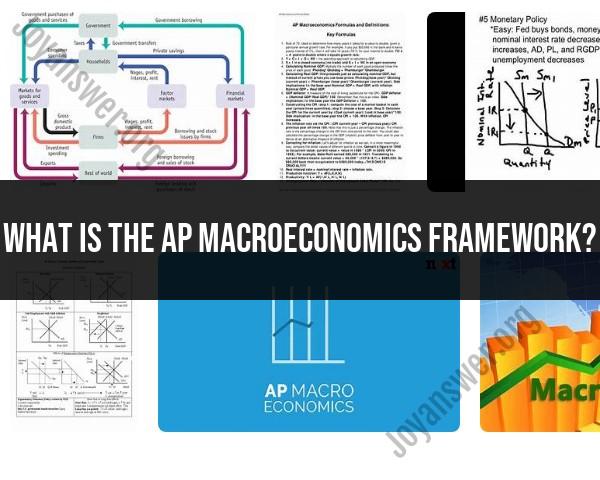What is the AP Macroeconomics framework?
The AP Macroeconomics framework is the structure and content outline designed by the College Board for the Advanced Placement (AP) Macroeconomics course. This framework serves as a guide for educators teaching AP Macroeconomics and outlines the essential concepts, skills, and learning objectives that students are expected to master in preparation for the AP Macroeconomics exam.
The framework covers various economic principles and topics within the field of macroeconomics, which focuses on the study of the economy as a whole, including aggregate measures like national income, inflation, unemployment, and economic growth.
Key Components of the AP Macroeconomics Framework:
Basic Economic Concepts: Fundamental concepts like scarcity, opportunity cost, production possibilities curve, and comparative advantage.
Measurement of Economic Performance: Understanding and analyzing measures such as gross domestic product (GDP), inflation, unemployment, and economic growth.
National Income and Price Determination: Analyzing the factors influencing national income, including aggregate demand and aggregate supply, the multiplier effect, fiscal policy, and the Phillips curve.
Financial Sector: Understanding the role of financial institutions, money supply, interest rates, and the functions of the Federal Reserve in influencing the economy.
International Economics: Exploring international trade, exchange rates, balance of payments, and their impact on the domestic economy.
Skills Emphasized:
- Analyzing economic data and graphs.
- Understanding economic models and applying them to real-world scenarios.
- Interpreting economic policies and their effects on the economy.
- Making connections between different macroeconomic concepts.
Purpose: The AP Macroeconomics course aims to provide students with a strong foundation in macroeconomic principles and analytical skills necessary to understand economic concepts, analyze economic data, and evaluate economic policies. It prepares students for the AP exam, where they are assessed on their understanding and application of macroeconomic concepts through multiple-choice questions and free-response questions.
Educators use this framework to structure their curriculum, select instructional materials, and design assessments aligned with the learning objectives outlined by the College Board for the AP Macroeconomics course.
What are the key components of the AP Macroeconomics framework?
The AP Macroeconomics framework outlines six key components that guide both the learning process and the content covered in the AP Macroeconomics exam. These components provide a structure for understanding the economy as a whole and analyzing its behavior. Here's a breakdown of each one:
1. Economic Measurements:
- This component focuses on the tools and measures used to analyze economic activity, such as Gross Domestic Product (GDP), unemployment rate, inflation rate, and interest rates. Students learn how to interpret these data points and understand their interrelationships.
2. Markets:
- Markets are the engines of a capitalist economy. This component dives into the principles of supply and demand, market equilibrium, competition, and market efficiency. Students analyze different types of markets and their impact on prices, resource allocation, and economic outcomes.
3. Macroeconomic Models:
- Models are simplified representations of complex systems. This component explores theoretical frameworks like the circular flow of income, aggregate demand and supply model, and economic growth models. Students learn how these models explain economic phenomena and predict outcomes based on changes in key variables.
4. Macroeconomic Policy:
- Governments and central banks use various tools to influence the economy. This component examines fiscal policy (taxes and spending) and monetary policy (interest rates and money supply) and their impact on macroeconomic goals like full employment, economic stability, and price stability. Students analyze the trade-offs and challenges associated with different policy choices.
5. International Trade and Finance:
- In today's globalized world, economies are interconnected. This component explores international trade theories, exchange rates, balance of payments, and global financial markets. Students understand how international trade and finance impact domestic economies and analyze policy issues like trade deficits and international debt.
6. Long-Run Growth:
- Economic growth is crucial for improving living standards. This component examines factors that contribute to long-run economic growth, such as technological advancements, investment, human capital, and institutional structure. Students analyze the challenges and opportunities for sustained economic growth in different countries and contexts.
By mastering these key components, students gain a comprehensive understanding of macroeconomics and develop the analytical skills necessary to critically examine economic issues, formulate informed opinions, and prepare for success in the AP Macroeconomics exam.
Remember, this is a general overview of the framework. Each component delves deeper into specific concepts and theories, offering a rich learning experience for those interested in macroeconomics.
I hope this explanation helps! Feel free to ask if you have any questions about specific topics within the framework.












